维多利亚时期【英文】
- 格式:ppt
- 大小:707.00 KB
- 文档页数:36
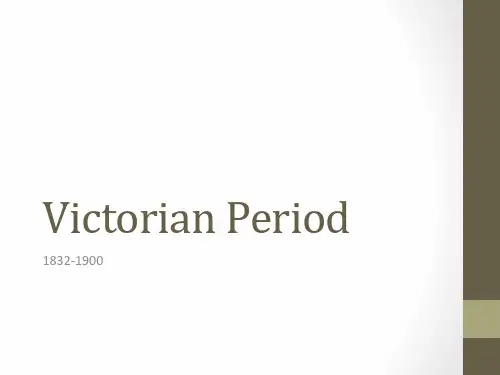

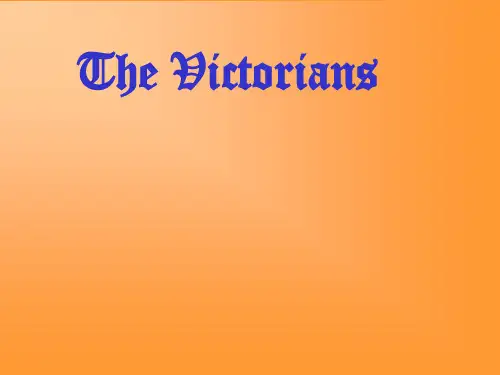
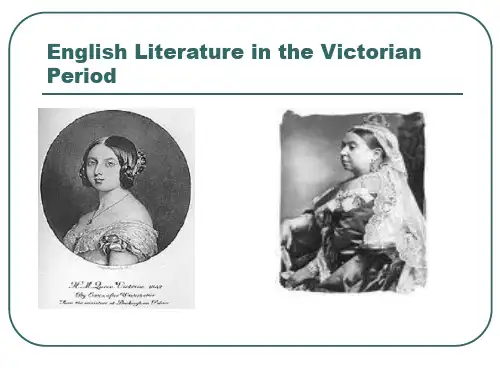
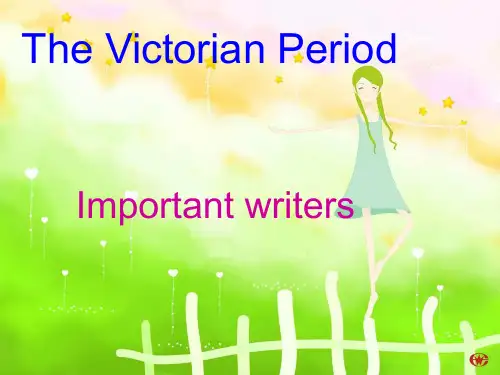

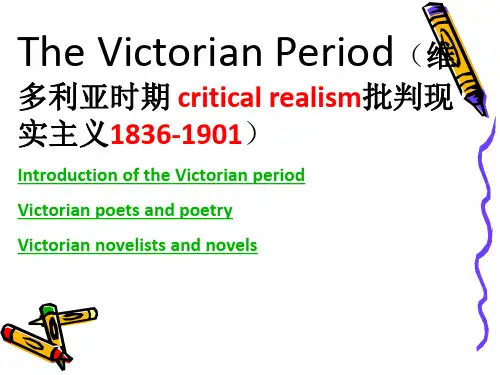
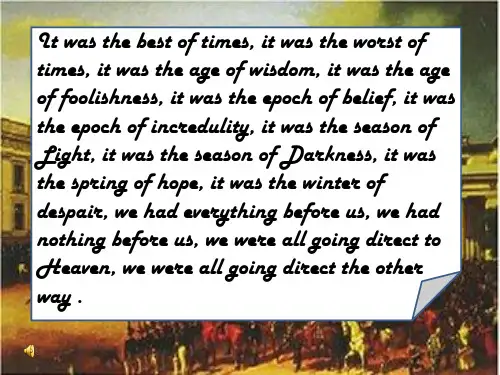
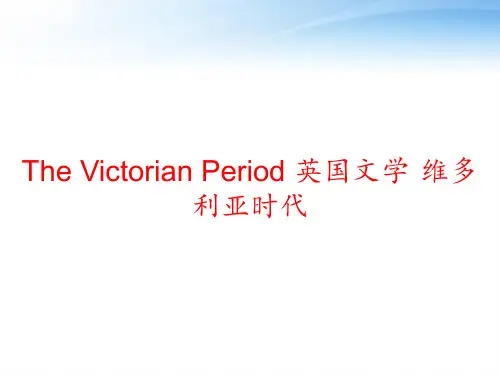
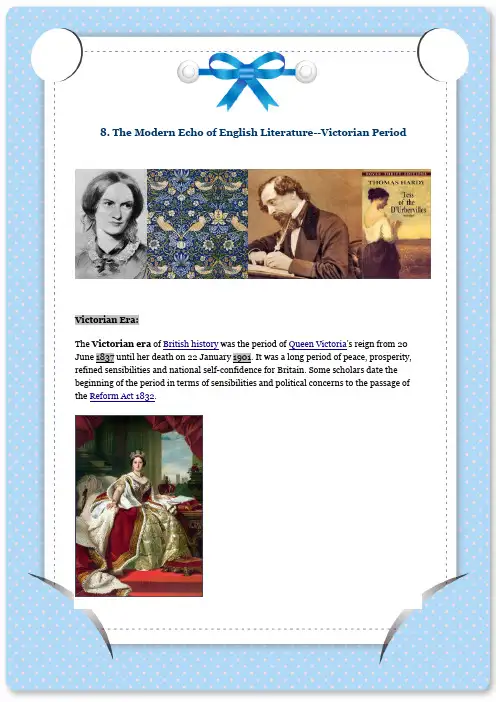
8. The Modern Echo of English Literature--Victorian PeriodVictorian Era:The Victorian era of British history was the period of Queen Victoria's reign from 20 June 1837 until her death on 22 January 1901. It was a long period of peace, prosperity, refined sensibilities and national self-confidence for Britain. Some scholars date the beginning of the period in terms of sensibilities and political concerns to the passage of the Reform Act 1832.Queen Victoria:Queen Victoria married her first cousin, Prince Albert, in 1840. Their nine children and 26 of their 34 grandchildren who survived childhood married into royal and noble families across the continent, tying them together and earning her the nickname "the grandmother of Europe".Golden Jubileejubilee ['dʒu:bli:] n.纪念或者庆典(特别指周年的)In 1887, the British Empire celebrated Victoria's Golden Jubilee.Diamond JubileeOn 23 September 1896, Victoria surpassed her grandfather George III as the longest-reigning monarch in English, Scottish, and British history. The Queen requested that any special celebrations be delayed until 1897, to coincide with her Diamond Jubilee.Movie: The Young Victoria 《年轻的维多利亚女王》Summaries•The Victorian era was a period of dramatic change that brought England to its highest point of development as a world power.•The early Victorian period (1830~48) saw the opening of Britain’s first railway and its first Reform Parliament, but it was also a time of economic distress. •Although the mid-Victorian period (1848~70) was not free of harassing problems, it was a time of prosperity, optimism, and stability.•In the later period (1870~1901) the costs of Empire became increasingly apparent, and England was confronted with growing threats to its military and economicpreeminence.•The common perception of the period is the Victorians are “prudish, hypocritical, stuffy, [and] narrow-minded”•The extreme inequities between men and women stimulated a debate about women’s roles known as The Woman Question.Literature of the Victorian Period:The drive for social advancement frequently appears in literature. This drive may take many forms. It may be primarily financial, as in Charl es Dickens’s Great Expectations 《远大前程》. It may involve marrying above one’s station, as in Charlotte Bronte’s Jane Eyre《简·爱》. It may also be intellectual or education-based. Typically, any such attempt to improve one’s social standing must be accompanied by “proper” behavior (thus helping to provide the period with its stereotype).维多利亚时期被文史家们分为三个阶段:维多利亚早期(1832~1848)、维多利亚中期(1848~1870)和维多利亚晚期(1970~1891)。

victorian period名词解释
维多利亚时期(Victorian period)指的是1837年至1901年之间,维多利亚女王统治英国的时期。
这是英国工业革命的巅峰时期,也是英国经济、文化和科学发展的黄金时代。
维多利亚女王在位期间,英国从一个农业为主的国家转变为一个工业和商业强国,成为了全球最大的经济体。
同时,维多利亚时期也是英国文学、艺术和建筑的重要时期,许多经典作品和建筑在这一时期诞生。
此外,维多利亚女王本人也成为了一个文化象征,她的形象和价值观影响了整个欧洲和北美。
课外拓展(维多利亚时期名词解释)1. English critical realism:English critical realism o f the 19th century flourished in the forties and in the early fifties. The critical realists described with much vividness and artistic skill the chief traits of the English society and criticized the capitalist system from a democratic view point. The greatest English realist of the time was Charles Dickens. With striking force and truthfulness, he pictures bourgeois civilization, showing the misery and sufferings of the common people. Another critical realist, William Makepeace Thackeray, was a no less severe exposer of contemporary society. Thackeray’s novels are mainly a satirical portrayal of the upper strata of society. Other adherents to the method of critical realism were Charlotte and Emily Bronte, and Elizabeth Gaskell. In the fifties and sixties the realistic novel as represented by Dickens and Thackeray entered a stage of decline. It found its reflection in the works of George Eliot. Though she described the life of the laboring people and criticized the privileged classes, the power of exposure became weaker in her works. She seemed to be more morally than socially minded. The English critical realists of the 19th century not only gave a satirical portrayal of the bourgeoisie and all the ruling classes, but also showed profound sympathy for the common people.2. Victorian period:It refers to the era of Queen Victoria’s reign (1837~1901). The period is sometimes dated from 1832 (the passage of the first Reform Bill), a period of intense and prolific activity in literature, especially by novelists and poets, philosophers and essayists. Dramatists of any note are few. Much of the writing was concerned with contemporary social problems: for instance, the effects of the industrial revolution, the influence of the theory of evolution, and movements of political and social reform. The following are among the most not able British writers of the period: Thomas Carlyle, Elizabeth Barrett Browning, Alfred Tennyson, Charles Darwin, W. M. Thackeray, Robert Browning, Edward Lear, Charles Dickens, Anthory Trollope, Charlotte Bronte, Emily Bronte, Anne Bronte, George Eliot, John Ruskin, Matthew Arnold, George Meredith, Dante Gabriel Rossetti, Christina Rossetti, William Morris, Samuel Butler, Swinburne, Thomas Hardy, Robert Louis Stevenson, Henry Arthur Jones, Oscar Wilde.3. Autobiography:It is an account of a person’s life by him or herself. The term appears to have been first used by Southey in 1809. In Dr. Johnson’s opinion no man was better qualified to write his life than himself, but this is debatable. Memory may be unreliable. Few can recall clear details of their early life and most are therefore dependent on other people’s impressions, of necessity equally unreliable. Moreover, everyone tends to remember what he or she wants to remember. Disagreeable facts are sometimes glossed over or repressed, truth may be distorted for the sake of convenience or harmony and the occlusions of time may obscure as much as they reveal.4. Regional novel: A regional writer is one who concentrates much attention on a particular area and uses it and the people who inhabit it as the basis forhis or her stories. Such a locale is likely to be rural or provincial. Once established, the regional novel began to interest a number of writers, and soon the regions described became smaller and more specifically defined. For example, the novels of Mrs. Gaskell (1810~1865) and George Eliot (1819~1880) centered on the Midlands, and those of the Bronte sisters were set in Yorkshire. There were also “urban”or “industrial”novels, set in a particular town or city, some of which had considerable fame in the 19th century. Notable instances are Mrs. Gaskell’s Mary Barton(1848), Charles Dickens’s Hard Times (1854) and George Eliot’s Middlemarch (1871~1872).5. Dramatic monologue:Dramatic monologue is a kind of poem in which a single fictional or historical character other than the poet speaks to a silent “audience”of one or more persons. Such poems reveal not the poet’s own thoughts but the mind of the impersonated character, whose personality is revealed unwittingly; this distinguishes a dramatic monologue from a lyric, while the implied presence of an auditor distinguishes it from a soliloquy. Major examples of this form in English are Tennyson’s “Ulysses” (1842), Browning’s “Fra Lippo Lippi”(1855), and T. S. Eliot’s “The Love Song of J. Alfred Prufrock” (1917). Some plays in which only one character speaks, in the form of a monologue or soliloquy, have also been called dramatic monologues; but to avoid confusion it is preferable to refer to these simply as monologues or as monodramas.6. Psychological novel:It is a vague term to describe that kind of fiction which is for the most part concerned with the spiritual, emotional and mental lives of the characters and with the analysis of characters rather than with the plot and the action. Many novelists during the last two hundred years have written psychological novels.7. Künstlerroman: It is a novel which has an artist (in any creative art) as the central character and which shows the development of the artist from childhood to maturity and later. In English literature the most famous example of a Künstlerroman is James Joyce’s A Portrait of the Artist as a Young Man. 8. Aestheticism: The term aesthetic has come to signify something which pertains to the criticism of the beautiful or to the theory of taste. An aesthete is one who pursues and is devoted to the “beautiful” in art, music and literature. And aestheticism is the term given to a movement, a cult, a mode of sensibility (a way of looking at and feeling about things) in the 19th century. Fundamentally, it entailed the point of view that art is self-sufficient and need serve no other purpose than its own ends. In other words, art is an end in itself and need not be (or should not be) didactic, politically committed, propagandist, moral or anything else but itself; and it should not be judged by any non-aesthetic criteria (e.g. whether or notit is useful).9. Naturalism:Naturalism is a post-Darwinian movement of the late 19th century that tried to apply the” laws” of scientific determinism to fiction. The naturalist went beyond the realist’s insistence on the objective presentation ofthe details of everyday life to insist that the materials of literature should be arranged to reflect a deterministic universe in which a person is a biological creature controlled by environment and heredity. Major writers include Crane, Dreiser, Norris, and O’Neill in America; Zola in France; and Hardy and Gissing in England. Crane’s “The Blue Hotel” (1898) is perhaps the best example in this text of a naturalistic short story.。